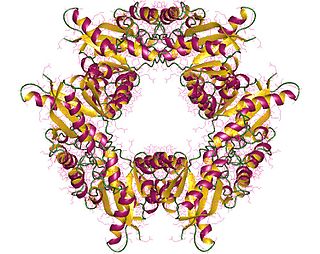
Nicotinamide (NAM) is a form of vitamin B3 found in food and used as a dietary supplement and medication. As a supplement, it is used by mouth to prevent and treat pellagra (niacin deficiency). While nicotinic acid (niacin) may be used for this purpose, nicotinamide has the benefit of not causing skin flushing. As a cream, it is used to treat acne.
Niacin, also known as nicotinic acid, is an organic compound and a form of vitamin B3, an essential human nutrient. Niacin is obtained in the diet from a variety of whole and processed foods, with highest contents in fortified packaged foods, meat, poultry, red fish such as tuna and salmon, lesser amounts in nuts, legumes and seeds. Niacin as a dietary supplement is used to treat pellagra, a disease caused by niacin deficiency. Signs and symptoms include skin and mouth lesions, anemia, headaches, and tiredness. Many countries require its addition to wheat flour or other food grains, thereby reducing the risk of pellagra.

Adenine is a nucleobase. It is one of the four nucleobases in the nucleic acid of DNA that are represented by the letters G–C–A–T. The three others are guanine, cytosine and thymine. Its derivatives have a variety of roles in biochemistry including cellular respiration, in the form of both the energy-rich adenosine triphosphate (ATP) and the cofactors nicotinamide adenine dinucleotide (NAD) and flavin adenine dinucleotide (FAD). It also has functions in protein synthesis and as a chemical component of DNA and RNA. The shape of adenine is complementary to either thymine in DNA or uracil in RNA.

Nicotinamide adenine dinucleotide (NAD) is a cofactor central to metabolism. Found in all living cells, NAD is called a dinucleotide because it consists of two nucleotides joined through their phosphate groups. One nucleotide contains an adenine nucleobase and the other nicotinamide. NAD exists in two forms: an oxidized and reduced form, abbreviated as NAD+ and NADH respectively.

Nicotinamide adenine dinucleotide phosphate, abbreviated NADP+ or, in older notation, TPN (triphosphopyridine nucleotide), is a cofactor used in anabolic reactions, such as the Calvin cycle and lipid and nucleic acid syntheses, which require NADPH as a reducing agent. It is used by all forms of cellular life.

Hartnup disease is an autosomal recessive metabolic disorder affecting the absorption of nonpolar amino acids. Niacin is a precursor to nicotinamide, a necessary component of NAD+.
DNA ligase (NAD+) (EC 6.5.1.2, polydeoxyribonucleotide synthase (NAD+), polynucleotide ligase (NAD+), DNA repair enzyme, DNA joinase, polynucleotide synthetase (nicotinamide adenine dinucleotide), deoxyribonucleic-joining enzyme, deoxyribonucleic ligase, deoxyribonucleic repair enzyme, deoxyribonucleic joinase, DNA ligase, deoxyribonucleate ligase, polynucleotide ligase, deoxyribonucleic acid ligase, polynucleotide synthetase, deoxyribonucleic acid joinase, DNA-joining enzyme, polynucleotide ligase (nicotinamide adenine dinucleotide)) is an enzyme with systematic name poly(deoxyribonucleotide):poly(deoxyribonucleotide) ligase (AMP-forming, NMN-forming). This enzyme catalyses the following chemical reaction
Isonicotinamide (pyridine-4-carboxamide) is the amide form of isonicotinic acid. It is an isomer of nicotinamide, which has the carboxamide group in the 3-position.
In enzymology, a malate dehydrogenase (NADP+) (EC 1.1.1.82) is an enzyme that catalyzes the chemical reaction
In enzymology, a NADPH—cytochrome-c2 reductase (EC 1.6.2.5) is an enzyme that catalyzes the chemical reaction
In enzymology, a NAD(P)+ transhydrogenase (Re/Si-specific (EC 1.6.1.2) is an enzyme that catalyzes the chemical reaction

In enzymology, a NAD(P)+-protein-arginine ADP-ribosyltransferase (EC 2.4.2.31) is an enzyme that catalyzes the chemical reaction using nicotinamide adenine dinucleotide

Nicotinamide phosphoribosyltransferase also known as pre-B-cell colony-enhancing factor 1 (PBEF1) or visfatin is an enzyme that in humans is encoded by the NAMPT gene. This protein is the rate-limiting enzyme in the Nicotinamide adenine dinucleotide (NAD+) salvage pathway that converts nicotinamide to nicotinamide mononucleotide in mammals to enable NAD+ biosynthesis. NAMPT has also been reported to be a cytokine (PBEF) that promotes B cell maturation and inhibits neutrophil apoptosis.

In enzymology, nicotinamide-nucleotide adenylyltransferase (NMNAT) (EC 2.7.7.1) are enzymes that catalyzes the chemical reaction

P7C3 is a drug related to latrepirdine (dimebon) which has neuroprotective and proneurogenic effects and may be potentially useful for the treatment of Alzheimer's disease and similar neurodegenerative disorders. The pharmacological effects of P7C3 in vitro resemble those of endogenous proneurogenic peptides such as fibroblast growth factor 1 (FGF-1), and the proneurogenic activity of P7C3 was around thirty times that of latrepirdine when they were compared in mice. P7C3 was chosen for further animal studies on the basis of favorable pharmacokinetic factors, such as its high oral bioavailability and long duration of action, but several other related compounds showed similar activity such as the more potent fluorinated analogue P7C3A20 which is up to ten times stronger again, and the methoxy analogue P7C3-OMe, for which it was determined that the (R) enantiomer is the active form.

NADH dehydrogenase is an enzyme that converts nicotinamide adenine dinucleotide (NAD) from its reduced form (NADH) to its oxidized form (NAD+). Members of the NADH dehydrogenase family and analogues are commonly systematically named using the format NADH:acceptor oxidoreductase. The chemical reaction these enzymes catalyze are generally represented with the follow equation;

Nicotinamide riboside (NR) is claimed to be a new form pyridine-nucleoside of vitamin B3 that functions as a precursor to nicotinamide adenine dinucleotide or NAD+.

Nicotinamide mononucleotide is a nucleotide derived from ribose and nicotinamide. NMN is made from B vitamins in the body, and is a molecule naturally occurring in all life forms. Like nicotinamide riboside, NMN is a derivative of niacin, and humans have enzymes that can use NMN to generate nicotinamide adenine dinucleotide (NADH). In mice, NMN enters cells via the small intestines within 10 minutes converting to NAD+ through the Slc12a8 NMN transporter. Because NADH is a cofactor for processes inside mitochondria, for sirtuins, and for PARP, NMN has been studied in animal models as a potential neuroprotective and anti-aging agent. Dietary supplement companies have aggressively marketed NMN products claiming those benefits. Doses of up to 500 mg was shown safe in men in a recent human study at Keio University School of Medicine, Shinjuku, Tokyo Japan. Multiple long-term human studies are underway.
Vitamin B3 is a vitamin that includes three forms: nicotinamide (niacinamide), niacin (nicotinic acid), and nicotinamide riboside. All three forms of vitamin B3 are converted within the body to nicotinamide adenine dinucleotide (NAD). NAD is required for human life and people are unable to make it within their bodies without either vitamin B3 or tryptophan. Nicotinamide riboside was identified as a form of vitamin B3 in 2004. The group is also occasionally referred to as the vitamin B3 complex.
This page is based on this
Wikipedia article Text is available under the
CC BY-SA 4.0 license; additional terms may apply.
Images, videos and audio are available under their respective licenses.











